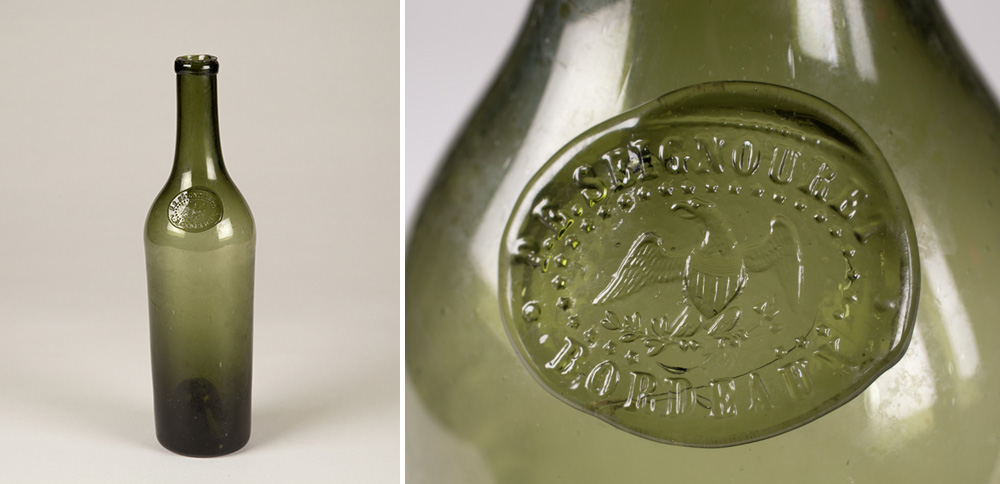Watch the video to see our version of Wine Jelly, adapted from Lafcadio Hearn's original recipe.
Chances are that when you had your first bowl of Jell-O, the flavor wasn’t “Red Wine.” Gelatin desserts, now seen as jiggling reminders of youth, were once commonplace at the tables of presidents and everyday citizens alike.
Gelatin was commercially available to home cooks by the late-19th century—previously it was made by boiling animal bones—and gelatin dishes were locally popular by the time writer Lafcadio Hearn arrived in New Orleans in 1877. Born in Greece and raised in Ireland, Hearn was immediately drawn to the local culture. His observations, which he captured in books including La Cuisine Créole—among the first published New Orleans cookbooks—and Gombo Zhèbes: Little Dictionary of Creole Proverbs were instrumental in the construction of local Creole identity. He was drawn to phenomena like Voodoo, dueling, Carnival, and Creole cuisine and was skilled in relaying these traditions’ perceived otherness to audiences around the country, and even some within the city.

Lafcadio Hearn is pictured alongside a first edition of La Cuisine Créole, which was published in 1885. (THNOC, gift of G. William Nott, 1974.61.10; THNOC, gift of Ralph M. Pons, 77-288-RL)
“Lafcadio Hearn is almost the patron saint of the New Orleans that we know,” said culinary historian Jessica B. Harris. “He recognized and codified so much of our culture and put it in context to outsiders. He just got New Orleans.”
Harris moderated THNOC’s symposium “Uncorked! A History of Wine in New Orleans” on November 2, 2019. It’s a topic that hits close to home, flavoring the history of THNOC’s new exhibition center, at 520 Royal Street. The building’s original owner, François Seignouret, imported wine from Bordeaux. So did the Brulatour family, who owned the building during Hearn’s New Orleans sojourn.

An 1850s wine bottle is stamped with the name “F. E. Seignouret.” François Seignouret imported goods from his native France to his property at 520 Royal Street, including wine from Bordeaux. (THNOC, gift of Isabel Puig, 1950.36 a,b)
A few things have changed since Hearn included a recipe for wine jelly in La Cuisine Créole. Alcohol has since been infused into gelatin in, shall we say, less tasteful ways. But perhaps more important, gelatin has been shunted to the end of the cafeteria line, its place in American cuisine drastically downgraded.
We’re bringing it back.
Wine Jelly, as prepared by the staff at The Historic New Orleans Collection. (Photograph by Eli A. Haddow; styling by Teresa Devlin)
Unlike some of the other dishes featured in Hearn’s cookbook, wine jelly is not strictly “Creole,” which is to say it’s not a New Orleans original. Mount Vernon and Monticello offer their own recipes for wine jelly, as enjoyed by presidents Washington and Jefferson (Jefferson's was one of only 10 recipes he hand wrote). And whereas Hearn supplements other recipes in La Cuisine Créole with insights into culinary and historical tradition, here he simply caps the entry with a short but encouraging line: “This should give great satisfaction.” But parents, be wary: this recipe calls for an entire bottle of wine, so it’s not for the kiddos.
That was cause enough for us to try it—and, given the source, we thought it just might be a sleeper hit for future dinner parties. Below, find an adapted version of Hearn’s recipe from La Cuisine Créole. Give it a try, and show us how yours comes out!
Wine Jelly adapted from La Cuisine Créole
Time: 30 minutes, plus resting
Yield: 4–6 servings
We tried this a few times, halving Hearn's recipe to make about a six-serving yield. The original recipe gives you the option of using lemon or vanilla extract, and it also calls for "any essence." We opted for lemon and no essence, but we could see some nutmeg or clove working. Or, if you'd like to make it "basic," a sprinkle of pumpkin spice may be in order. It's fall, after all.
Ingredients
3/4 ounces packaged packaged gelatine (three 1/4 ounce packets)
1 scant cup white sugar
The juice and grated rind of one lemon
1 egg white
1/2 teaspoon lemon extract
1 cup red Bordeaux wine
Instructions
Place gelatine in a large bowl and pour one cup of cold water on it. Let it soften for an hour or more. When ready to make the jelly, add 3/4 cup of boiling water to the gelatine mixture and stir until gelatin is dissolved. Next, add the sugar, the lemon juice, and rind, and stir until incorporated. Beat the egg white well and stir briskly into the mixture.
Put the mixture over a gentle fire and let it simmer slowly. Remove it from the heat as soon as it comes to a soft boil, then add the wine and lemon extract. Strain the mixture through cheesecloth and refrigerate until wiggly, 8 hours or overnight.
Serve in your fanciest goblet with whipped cream. As Lafcadio Hearn says, “This should give great satisfaction.”
—Eli A. Haddow, marketing associate













